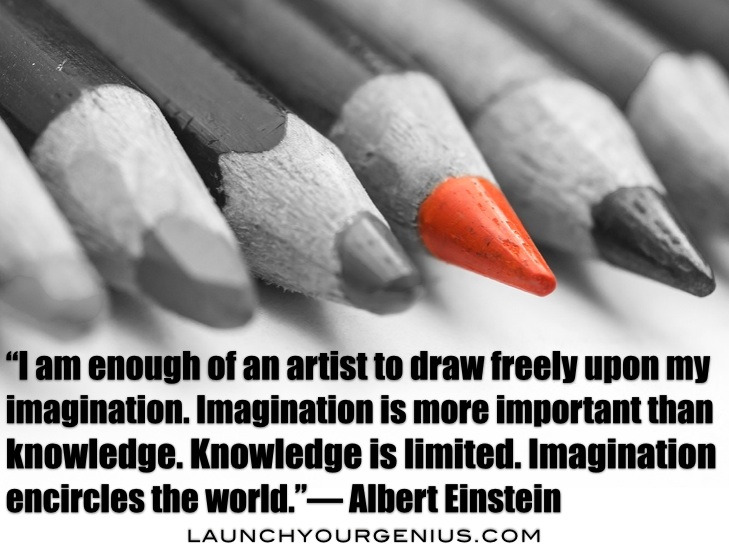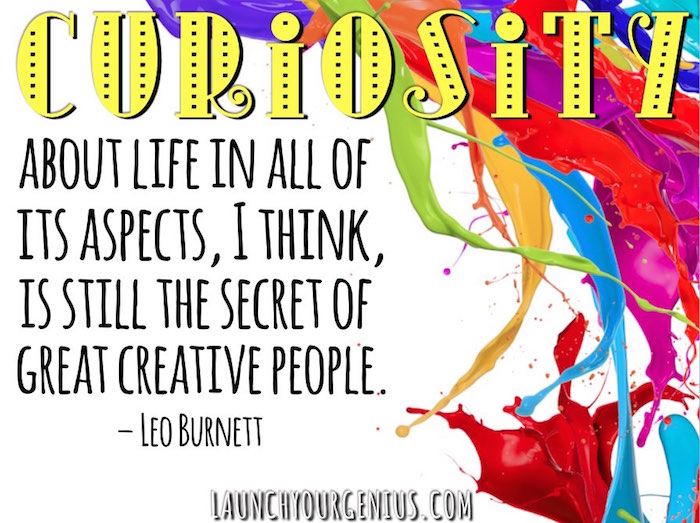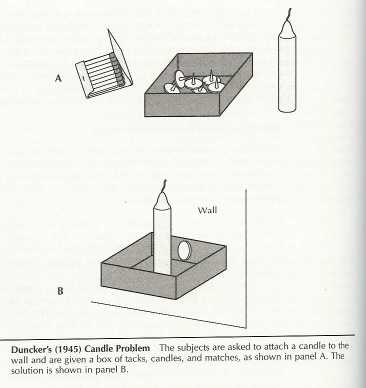“Curiosity about life in all of its aspects, I think, is still the secret of great creative people” – Leo Burnett
You are a creative individual.
Over the years and over hours of practice, you may have begun accepting and unleashing your creativity.
You display great curiosity in all things and do not miss an opportunity to be creative.
You mix and match and you connect and combine.
You have a sacred creative space, your personal studio that you take refuge in.
You have even made the effort to make creativity a habit by practicing daily.
But you feel like you are doing more of the same and would like to shake things up a bit.
Do you ever wonder how to take a huge leap into the next level of being creative?
Do you ever wonder how to shake off the creative doldrums?
Here are 10 unconventional ways to be highly creative.
This is part-1 of the two part series on Unconventional Creativity.
1. Salvador Dali’s Slumber with a key
“You have to systematically create confusion, it sets creativity free. Everything that is contradictory creates life”― Salvador Dali
Salvador Dali, the famous painter had a practice that he wrote in his book, 50 Secrets of Magic Craftsmanship.
He called it “The secret of the slumber with a key.”
Dali says that you should seat yourself in a bony Spanish style armchair.
Tilt your head back and rest on the leather back.
While you are resting in this position, Dali suggests that you gently hold a key pressed between the thumb and forefinger of your left hand.
Your hands should hang outside the arms of the chair suspended in a state of relaxation.
Before this relaxation, place an upside down plate under the hand on the floor.
I am guessing that a metal plate will produce the best waking up results.
Dali says that you “let yourself be progressively invaded by a serene siesta” and when the key drops, you will wake up.
I believe that the idea is to enter into the lucid state between deep sleep and wakefulness.
This alpha wave sleep or post-beta state between the waking consciousness and deep theta or delta sleep is a state of fertile imagination.
The technique I have used in the past to jump start creative ideas is to take a short nap in an armchair and set a gentle timer for a few minutes.
I pre-calibrate my mind with the creative problems that I have and off I go.
After a few minutes the timer gently wakes me up and I have the possibility of new creative perspectives.
After I wake up, I write down my dream or my association with ideas or solutions if I have any.
2. Edison’s Technique of Hypnagogic Creativity
“To invent, you need a good imagination and a pile of junk.”― Thomas A. Edison
While we are in the matters of lucid states and creativity, Edison’s technique deserves a quick mention.
Edison used to go into a daydream and a reverie to wander in his imagination while sitting in his favorite chair.
He would have a table nearby with a notebook and a pen handy.
He would grip steel ball bearings in his hands and place metal plates or buckets on his sides.
As he would go into a reverie-state between sleep and wakefulness, he would drop the ball and wake up when the ball fell on the plate.
Edison would then proceed to quickly record his ideas in the notebook.
This transitional and super-creative state between sleep and wakefulness is called HYPNAGOGIA.
Now you may not be too fond of waking up in an armchair with a start.
If you are easily surprised or have other medical conditions, you should not use techniques like Dali’s or Edison’s.
However, you may set a gentle timer like I do and rest in your favorite chair for a few minutes.
When the timer goes off, you drift back from your reverie and jot down any ideas that you have had in those few minutes.
Also, the state just before we wake up and go off to sleep is considered to be very rich in imagination.
A technique that I use sometimes is to drop a problem off in my mind that I want a creative solution to before going to sleep at night.
I keep a notebook and pencil ready on the table next to the bed.
Sometimes I wake up in the middle of the night with a solution. Sometimes the solution comes to me early in the morning between sleep and wakefulness when my mind is still infused with alpha waves.
“I am enough of an artist to draw freely upon my imagination. Imagination is more important than knowledge. Knowledge is limited. Imagination encircles the world.”― Albert Einstein
3. The Art Of Wabi-Sabi
“Wabi-sabi nurtures all that is authentic by acknowledging three simple realities: nothing lasts, nothing is finished, and nothing is perfect.”- Richard Powell
Wabi-sabi is a Japanese idea that is based on the acceptance and the illumination of the imperfect and the transient.
The idea that everything is transient and imperfection is not an exception but the rule of life fuels the idea of wabi-sabi.
Wabi-sabi highlights and accepts imperfection, and even glorifies it.
For example, wabi-sabi encourages a slight imperfection or an artistic crack that develops in a ceramic pot after the firing process.
Instead of keeping only the ideas and artwork that you think are perfect, you allow and even highlight the imperfections.
Instead of perfection, you embrace imperfection.
Instead of perfect symmetry, you are content and even encourage asymmetry.
Instead of waiting for perfect completion, you launch the seemingly incomplete.
Instead of regularity, you sometimes go for irregularity or roughness.
Instead of covering up creative flaws, you display and highlight them to see where their inherent beauty leads you.
“But when does something’s destiny finally come to fruition? Is the plant complete when it flowers? When it goes to seed? When the seeds sprout? When everything turns into compost?”― Leonard Koren, Wabi-Sabi: for Artists, Designers, Poets & Philosophers
An example of wabi-sabi:
I used to be a t-shirt designer and concept visualizer many years before. One of our main interests was to screen print and hand-paint t-shirts transforming them into unique and artistic pieces of clothing.
I encountered the idea of wabi-sabi when the screen would accidentally bleed through some dye on a few of the shirts.
If you have screen printed before, you know that it is normal to have a few misses and leaks.
There would be a spot of color in the most inopportune of places like the sleeve or at the back of the shirt.
We were getting rid of the shirts or wearing them ourselves as work shirts.
But then we had a creative stroke of insight.
Instead of dismissing the imperfections, why not work with them. We hand painted the areas where there were paint blotches on the shirts.
A blotch on the sleeve transformed into a design incorporating the flaw. Not only were we able to use the imperfection but we also made new pieces of creative artwork with them.
The results were quite satisfying.
Instead of making your creativity perfect, stay with imperfections. See where transience, imperfection and incompleteness lead you in your creative path.
“The tides of time should be able to imprint the passing of the years on an object. They physical decay or natural wear and tear of the materials used does not in the least detract from the visual appeal, rather it adds to it. It is the changes of texture and colour that provide the space for the imagination to enter and become more involved with the devolution of the piece. Whereas modern design often uses inorganic materials to defy the natural ageing effects of time, wabi sabi embraces them and seeks to use this transformation as an integral part of the whole. This is not limited to the process of decay, but can also be found at the moment of inception, when life is taking its first fragile steps toward becoming.”― Andrew Juniper, Wabi Sabi: The Japanese Art of Impermanence
4. Dr. Seuss’s Bet
“Think left and think right and think low and think high. Oh, the thinks you can think up if only you try” – Dr. Seuss
Dr. Seuss wrote his famous children’s book, The Cat in The Hat in 225 words.
Bennett Cerf, Dr. Seuss’s publisher knew that Seuss had struggled to write The Cat in the Hat with such a limitation.
In a bid to up the creative ante and perhaps to make some easy money, he made a bet with Dr. Seuss.
The bet was for Seuss to write a new book using only 50 words or less.
Dr. Seuss was not one to give up or give in easily.
Thus, Green eggs and Ham was born.
It used only 50 words: a, am, and, anywhere, are, be, boat, box, car, could, dark, do, eat, eggs, fox, goat, good, green, ham, here, house, I, if, in, let, like, may, me, mouse, not, on, or, rain, Sam, say, see, so, thank, that, the, them, there, they, train, tree, try, will, with, would, you. Read the CNN article here.
Green Eggs and Ham went on to be the forth most sold children’s book of all times.
It is also an elegant example of the value of restrictions in the creative process. I have written about creative restrictions and rules here.
But this example from Dr. Seuss takes restriction to a new level.
The idea is that if you seriously limit the amount of materials or words that you can use, you have to be super creative in your approach.
You are forced to try and attempt things that have not been done before by you.
It pushes your creative abilities over the top and some more in search of a solution within the restrictions.
5. Functional Fixedness
“Creativity is an act of defiance.” ― Twyla Tharp
What is functional fixedness?
It is a cognitive bias that limits you to use an object in the way that it is traditionally used and not in any other creative way.
So if you have a toothbrush and you can only see brushing teeth with it, you are resorting to functional fixedness.
If you see a toothbrush and you can think of painting with it or cleaning dirt off the grout of your tiles or using the soft bristles to do delicate cleaning tasks, you are shaking off functional fixedness.
In 1945, Karl Duncker demonstrated functional fixedness in his classic candle experiment.
The article was titled On problem-solving, and published in the Psychological Monographs.
Duncker gave participants a candle, thumbtacks in a box and a book of matches. The objective is to attach the candle to the wall while preventing wax from dripping on the table.
People attempted to attach the candle to the wall using thumbtacks but it did not work.
Some people tried to melt the side of the candle and glue it to the wall but that did not work either.
The idea is to overcome “functional fixedness” and eventually people figured out a creative way to thumbtack the box to the wall and place the candle inside.
The trick to solving this problem is to have the insight to use the box as a candle holder instead of using it as a thumbtack box.
Duncker found that people had a difficult time to re-conceptualize the box of thumbtacks and use it for a different purpose.
Candle Problem Image Credit: By Karl Duncker [Public domain], via Wikimedia Commons.
In a research paper titled “Functional Fixedness as related to problem solving: A repetition of three experiments” in the Journal of Experimental Psychology by Robert Adamson in 1952, it was shown that this bias could be prevented.
Experimental participants were given three boxes with candles, tacks and the matches. This burdened them with a prior usage for the materials.
Control Participants were given empty boxes instead of filled ones.
Control Participants were two times more likely to solve the problem of the candle when fixed function as a container was separated with the objects or thumbtacks, candles and matches in this case.
Adamson says:
“The results of the box problem, confirm Duncker’s finding that functional fixedness results from pre-utilization. The performance of the experimental group was markedly inferior to that of the control with respect both to the number of solutions obtained and the time required to reach solution. Prior usage of the boxes as containers inhibited their being used as platforms.”
Interestingly, research also shows that children before the age of 7 show less functional fixedness than those after that and adults. This can explain in part why younger children can be highly creative.
DO you have functional fixedness in your creative projects and in your creativity?
Ask:
Can you find new functions for the elements of your creative projects?
What are the fixed functions that you are confining yourself within?
Are you leaving creative solutions on the table by not implementing them due to functional fixedness?
This is the end of Part-1. You can read part-2 here!
Now over to you!
Did this post resonate with you?
Do you have any ninja techniques that you can share with us that are unconventional ways to be creative.
I would love to hear from you in the comments below!






ikechi says
Wow! I love the creativity is exhibited by the legends. These guys really used unconventional methods to use their creative minds. What a great post. Thanks for sharing
Harish says
Hello Ikechi,
Thanks a lot for your comment! And thank you for your kind words! I agree that some of the methods used are quite unconventional. It is interesting to see how various creative people used methods and habits that suited them and worked for them. The commonality is that they were all highly prolific creators!
Have a nice weekend!
Harish
Yvonne I. Wilson says
Hi Harish, it is my first time visiting your website and discovered you through the ABC
Very interesting article I must commend you on. We are a beautiful part of creation, highly gifted and creative – it is embedded into our DNA. I cannot imagine anyone not wanting to discover their creative side and do something great with it.
I love the way you carefully articulated each point on how to be creative. I have a way with quotes, they have a way of motivating me and pointing me in the direction to do something better with myself. I am inspired to write when I come across them.
Thanks for sharing and being a blessing to us
Harish says
Thanks a lot for visiting, Yvonne! Welcome to LYG!
Thanks for your kind words on the post. I love the choice of words that you use: “We are a beautiful part of creation, highly gifted and creative – it is embedded into our DNA. I cannot imagine anyone not wanting to discover their creative side and do something great with it.”
I 100% agree with those words! the only problem is that people forget that sometimes and say: What me? Creative? Every single person is inherenty highly creative and it is in their DNA! And they used to be super creative as children. As they grow up, they wrap the cloak of beliefs, conditioning and forgetfulness on their amazing creative powers. It is indeed the mission of LYG to remind everyone of their creativity and encourage them to be habitually creative in their lives.
I love quotes too. A well placed quote in a very powerful reminder of the message that is being conveyed.
Thanks again for visiting!
Have a great weekend!
Harish